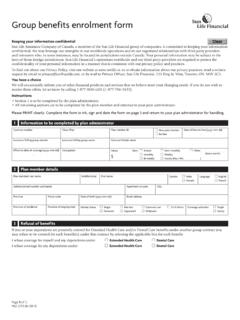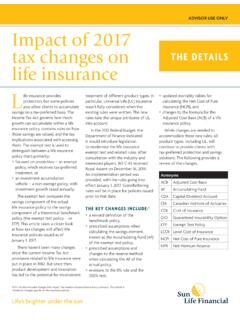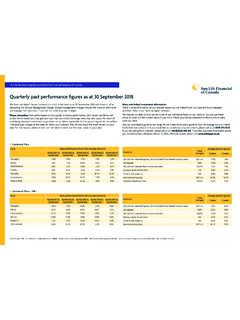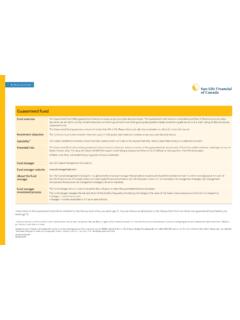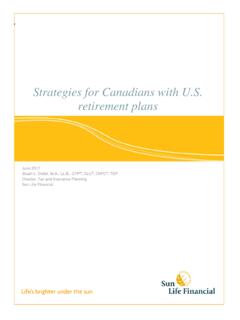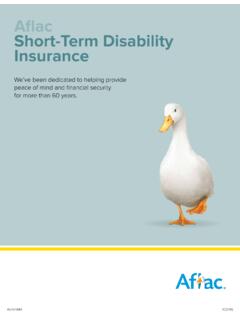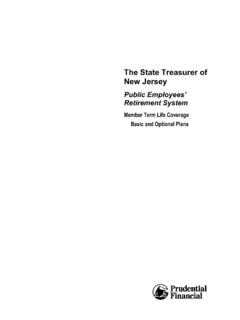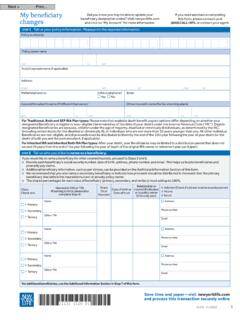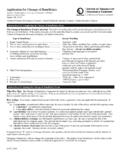Transcription of LEVERAGING A LIFE INSURANCE POLICY
1 ADVISOR USE ONLYLEVERAGING A LIFE INSURANCE POLICYA GUIDE FOR LAWYERS, ACCOUNTANTS AND INSURANCE ADVISORSU sing life INSURANCE as collateral for personal and business planningLife s brighter under the sunThis guide is intended to be a source of information on the LEVERAGING process, but not a substitute for independent legal, tax, accounting or other professional advice. While the LEVERAGING concept can be beneficial to both individuals and businesses, there are risks involved in such a strategy and the issues can be complex. No person or business should undertake a LEVERAGING strategy without a thorough review of the financial risks as well as the potential legal, tax and accounting implications that apply to their ADVISOR S GUIDE TO LEVERAGING A LIFE INSURANCE POLICY 3 LIFE INSURANCE A FLEXIBLE FINANCIAL PLANNING TOOL 4 Why buy life INSURANCE with cash surrender values (CSV)?
2 4 Accessing cash value directly POLICY withdrawals or POLICY loans 5 Accessing cash value indirectly borrowing from a financial institution ( LEVERAGING ) 6 LEVERAGING A CLOSER LOOK AT HOW IT WORKS 7A quick-step approach to the loan calculation 7 Distinction between a collateral assignment and a movable hypothec 8 LEVERAGING in action two examples 8 Key LEVERAGING strategies for corporations and their shareholders 12 Living buyout 12 Buy out a partner or shareholder 12 Living pension payment 12 Provide an ongoing pension to a shareholder 13 Personal loan with corporate POLICY 13 Immediate leverage for premium 14 RISKS OF LEVERAGING 16 Mortality risks 16 Financial risks 17 Tax risks 18 Retirement compensation arrangement risk 19 GLOSSARY 204 AN ADVISOR S GUIDE TO LEVERAGING A LIFE INSURANCE POLICY LIFE INSURANCE A FLEXIBLE FINANCIAL PLANNING TOOLLife INSURANCE policies with a cash value component, such as universal life and permanent life policies.
3 Can be flexible financial planning tools for both individuals and businesses. While term life INSURANCE provides temporary protection, permanent life INSURANCE provides lifelong protection and most permanent policies also create an opportunity to build cash cash value POLICY provides an excellent means of deferring tax on the interest earned, most often for use in retirement. It can play an integral role in business succession planning by providing tax-efficient funding for the purchase of a business owner s interest or funding for the owner s retirement income. While the purchaser usually has a specific planning objective when buying a permanent life INSURANCE POLICY , the flexibility of these policies can help purchasers achieve their original goal as well as new objectives and needs that may arise over many cases, access to the cash value of the POLICY during the lifetime of the insured is an integral part of the planning are three main ways to do this.
4 Withdraw funds from the policytake out a POLICY advance or POLICY loan1 from the INSURANCE companytake out a loan from a financial institution, using the POLICY as collateral1 See glossary for more we briefly discuss POLICY loans and withdrawals in the sections that follow, this guide focuses on the third method of accessing a POLICY s cash value LEVERAGING the POLICY by using it as collateral for a loan from a financial BUY LIFE INSURANCE WITH CASH SURRENDER VALUES (CSV)?Both individuals and businesses can take advantage of a permanent life INSURANCE POLICY . While there are no restrictions on the use of an INSURANCE POLICY s cash value, an increasing number of people use these funds as an additional source of retirement income. They can purchase a POLICY during their high-income earning years, make significant payments and earn tax-deferred interest. Of course, while building the cash value of their POLICY , they also enjoy the ongoing life INSURANCE protection that the POLICY their income decreases at or near retirement, these individuals can access the cash value of the POLICY in one of the three ways described previously (withdrawal, POLICY loan or loan from a financial institution) to supplement their retirement are a number of ways businesses can benefit from the purchase of permanent life INSURANCE on the lives of one or more employees, partners or shareholders.
5 benefits include:providing collateral for a business loancovering anticipated business losses if a key employee or an owner-manager dies or retiresproviding tax-free funds to finance a buyout or redemption of a deceased shareholder s interestAN ADVISOR S GUIDE TO LEVERAGING A LIFE INSURANCE POLICY 5 accumulating tax-deferred funds to buy out a retiring partner s or shareholder s interestfunding retirement income for an active shareholderSome of these strategies are discussed in more detail in the section entitled Key LEVERAGING strategies for corporations and their shareholder. ACCESSING CASH VALUE DIRECTLY POLICY WITHDRAWALS OR POLICY LOANST here are two ways a POLICY owner can directly access the cash value of the POLICY through POLICY withdrawals or a POLICY WITHDRAWALSMost cash value policies allow for ongoing POLICY withdrawals. However, there are tax implications to consider with any , all withdrawals are final and may not be repaid to the insurer.
6 This means that any subsequent payments are considered a new premium and must meet the conditions set out in the INSURANCE contract and the Income Tax Act (ITA) to maintain their tax-exempt , all or a portion of the withdrawal may be taxable under section 148 of the ITA. Whenever the cash surrender value (CSV) of a POLICY exceeds the adjusted cost basis (ACB) of the POLICY , withdrawals will trigger taxation. The taxable portion of each withdrawal is the proportion of the amount withdrawn to the total POLICY fund value times the total gain on the POLICY at the time. For example, if 30 per cent of the total CSV is comprised of non-taxable ACB, and 70 per cent of the total CSV is taxable, then 30 per cent of the withdrawal will be treated as a withdrawal of non-taxable ACB, and 70 per cent of the withdrawal will be , the ACB of the life INSURANCE POLICY will reach zero and when that happens 100 per cent of a withdrawal will be LOANSMost cash value policies also allow the policyholder to take out a POLICY loan from the insurer against the cash value of the POLICY .
7 While most people refer to this approach as a POLICY loan, in reality it is an advance against the death benefit paid under the terms of the INSURANCE POLICY . So, while terms like POLICY loan and borrow are used to describe this method of accessing the cash value of a POLICY , the legal requirements and obligations of this arrangement are different from when a person uses a cash value POLICY as collateral for a loan or line of credit from a financial loans taken in amounts that do not exceed the POLICY s ACB will be tax free, and will reduce the POLICY s ACB. If the POLICY loan exceeds the POLICY s ACB, the amount borrowed in excess of the POLICY s ACB will be fully There is no proportional taxation as is the case with POLICY withdrawals. 2 See section 148(9) of the a POLICY withdrawal, amounts borrowed can be repaid. If the original loan was not taxable, the repayment will merely increase the POLICY s ACB.
8 If the original loan had a taxable portion, the amount repaid will be deductible from the policyholder s income up to the previously taxed portion. The repayment less the deductible portion will increase the POLICY s AN ADVISOR S GUIDE TO LEVERAGING A LIFE INSURANCE POLICYACCESSING CASH VALUE INDIRECTLY BORROWING FROM A FINANCIAL INSTITUTION ( LEVERAGING )The third method of accessing the cash value of a life INSURANCE POLICY is to use the cash value of the POLICY as collateral for a loan from a financial institution. This is often referred to as LEVERAGING the life INSURANCE primary advantage of this approach is that under current tax laws, the loan proceeds can be received tax free. In addition, loan interest may be deductible if the loan proceeds are used to generate income from business or property. Where the POLICY is assigned to the financial institution as a condition of the loan, a portion of the INSURANCE costs may be deductible.
9 The amount deductible is based on the lower of the premium paid and the net cost of pure INSURANCE (NCPI) as outlined in ITA paragraph 20(1)( ).The loan agreement with the financial institution will provide the conditions for the loan repayment. In some cases, the borrower may have to make interest or capital payments on the outstanding balance. This and other risks associated with LEVERAGING are discussed in the Risks of LEVERAGING section of this guide, on page , cash value life INSURANCE remains one of the best ways of achieving long-term growth whether your client leverages or not. In most cases, your client s decision to make a POLICY withdrawal, borrow from the POLICY or leverage won t be made for many years. A renewed assessment of the risks can be made at that time. Whatever decision is made, the tax-deferred growth within the POLICY remains available for your client s benefit, as does the tax-free payment of the death benefit.
10 Whether LEVERAGING is used in a personal or business context, the basic structure is the same. At the time of the loan application, the financial institution will issue a line of credit or a loan to the POLICY owner, taking the INSURANCE POLICY as collateral either through a collateral assignment or, in Quebec, a movable hypothec. The maximum amount that can be borrowed is based on a specified percentage of the CSV, usually 50 to 90 per cent depending on the investment options chosen by the POLICY owner. In most cases, the more conservative the investments, the higher the borrowing limit. Interest may be paid annually or added to the loan balance, depending on the lender and the terms of the loan. Because the rate earned within the POLICY may be less than the financial institution s lending rate, it is possible that the loan balance will exceed the CSV. If so, the financial institution may require additional collateral or a partial repayment of the loan (see Risks of LEVERAGING on page 17).
